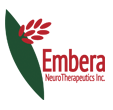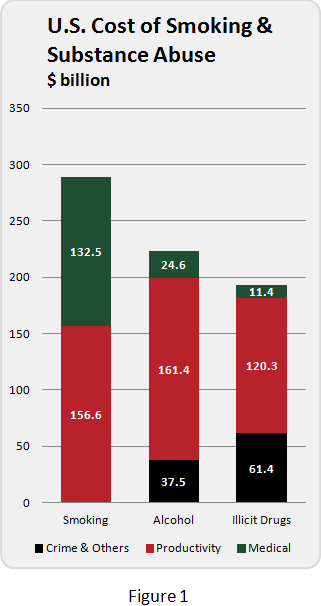Market / Unmet Medical Needs
Smoking, cocaine dependence and other addictions continue to be global unmet medical needs that result in significant healthcare burdens and productivity losses (See Figure 1), making a compelling economic case for effective new treatments. At 443,000 deaths annually, smoking exacts a particularly heavy toll as the leading cause of lung cancer, chronic pulmonary obstructive disease (COPD) and preventable premature death in the U.S. As a pharmaceutical smoking cessation treatment, EMB-001 could have a dramatic effect on reducing lung cancer and COPD rates.
Cocaine is involved in 13% of admissions to drug treatment programs1 and 43% of visits to emergency departments for drug misuse or abuse2. There are currently no approved treatments for the nearly one million people in the U.S. who are addicted to cocaine3.
Most current medications for treating substance use disorders either (i) block the addictive substance’s effect (but do not prevent its use) or (ii) mimic its effect. These treatment strategies have seen success, but it has been limited. In 2012, for example, 22.3 million U.S. smokers tried to quit and only 12% were successful (See Figure 2). Alcohol and illicit drug addiction continues to affect 20 million people in the U.S., as well.
With a $1.7B worldwide market and over 1 billion smokers, there is a significant unmet need for a more effective smoking cessation treatment with a favorable safety profile. (See figure 2 for recent US smoking cessation rates.)
A new, effective therapy would have a significant market impact. Embera believes EMB-001 has the potential to address this need.
EMB-001 also has the potential to address the significant unmet need for medications to treat stimulant addictions, specifically cocaine and methamphetamine, which currently have no approved treatment. Payors confirm the need for stimulant addiction treatments. In a survey of payors representing 70 million covered lives, 76% indicated a high level of unmet need for stimulant use disorder treatments and 74% indicated development of new pharmacotherapies for treatment is important.4 Insight into the market potential for addiction medications arises from a comparable product, Indivior’s Suboxone® for opioid dependence, which achieved $1.5B in peak sales. Over 780,000 US patients sought treatment for cocaine dependence in 2014 (Figure 3).
Footnotes
1. – NIDA Research Report Series: Cocaine Abuse & Addiction, NIH Publication Number 10-4166, Printed May 1999, Revised November 2004, Revised June 2009, Revised September 2010
2. – Substance Abuse and Mental Health Services Administration, Center for Behavioral Health Statistics and Quality. (December 15, 2011).The DAWN Report: Illicit Drug-Related Emergency Department Visits in Metropolitan Areas of the United States: 2009. Rockville, MD.
3. – Substance Abuse and Mental Health Services Administration, Results from the 2013 National Survey on Drug Use and Health: Summary of National Findings, NSDUH Series H-48, HHS Publication No. (SMA) 14-4863. Rockville, MD: Substance Abuse and Mental Health Services Administration, 2014.
4. – US Payer Feedback on Stimulant Addiction Treatment, Amy M. Duhig, PhD, Director, Outcomes Research, Global Health Economics and Outcomes Research, Xcenda, AmerisourceBergen.
Citations
Figure 1: The Health Consequences of Smoking – 50 Years of Progress, A Report of the U.S. Surgeon General, U.S. Department of Health and Human Services; 2014; National Drug Intelligence Center 2011 The Economic Impact of Illicit Drug Use on American Society. Washington D.C.: United States Department of Justice; Economic costs of excessive alcohol consumption in the U.S., 2006, Am J Prev Med. 2011 Nov;41(5):516-24.
Figure 3: Substance Abuse and Mental Health Services Administration, Results from the 2013 National Survey on Drug Use and Health: Summary of National Findings, NSDUH Series H-48, HHS Publication No. (SMA) 14-4863. Rockville, MD: Substance Abuse and Mental Health Services Administration, 2014.




